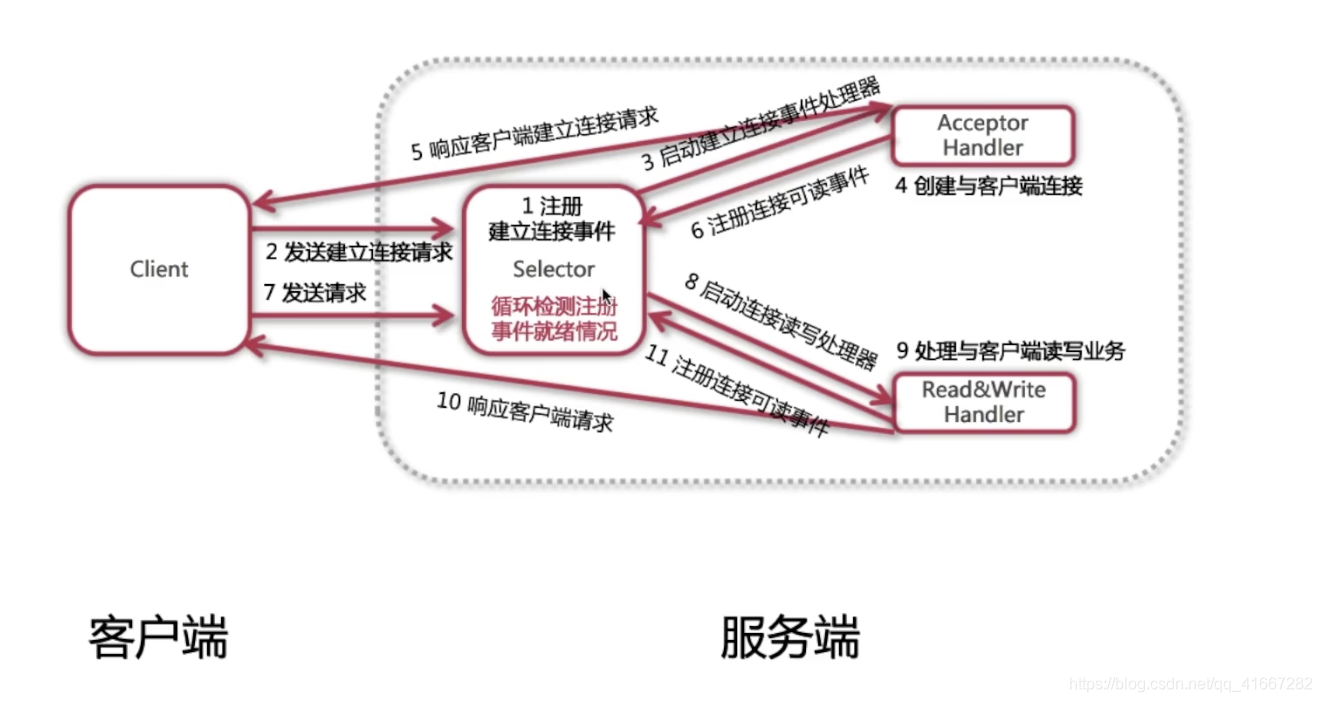NIO:non-blocking input output

NIO核心类
Channel
- 类似于Stream,但是是双向的
- 非阻塞性
- 操作唯一性,通过Buffer
文件类:FileChannel
UDP类:DatagramChannel
TCP类:ServerSocketChannel/SocketChannel
使用:
//服务器通过Socket创建channel
ServerSocketChannel serverSocketChannel = ServerSocketChannel.open();
//绑定端口
serverSocketChannel.bind(new InetSocketAddress(8000));
//监听客户端连接,建立socketChannel连接
SocketChannel socketChannel = serverSocketChannel.accept();
//客户端连接远成主机
SocketChannel socketChannel = SocketChannel.open(new InetSocketAddress("127.0.0.1", 8000));
Buffer
作用:读写Channel中的数据
属性:
- Capacity
- Position
- Limit
- Mark
使用:
//初始化长度为10的Buffer
ByteBuffer byteBuffer = ByteBuffer.allocate(10);
//写入数据
byteBuffer.put("abc", getBytes(Charset.forName("UTF-8")));
//将写切换为读
byteBuffer.flip();
byteBuffer.get();
//记录当前position的位置
byteBuffer.mark();
//回到mark标记的位置
byteBuffer.reset();
byteBuffer.clear();
Selector
作用:I/O就绪选择
使用:
//创建selector
Selector selector = Selector.open();
//将channel注册到selector上,监听就绪事件
SelectionKey selectionKey = channel.register(selector, SelectionKey.OP_READ):
//阻塞等待channel有就绪事件发生
int selectNum = selector.select();
//获取发生就绪事件的channel集合
Set<SelectionKey> selectedKey = selector.selectedKeys();
实战-网络聊天室
基本功能:一个客户端发消息其他客户端能收到消息。
客户端:
- 连接服务端
- 接收服务端响应
- 发送消息给服务端
package com.imooc;
import java.io.IOException;
import java.net.InetSocketAddress;
import java.nio.channels.SelectionKey;
import java.nio.channels.Selector;
import java.nio.channels.SocketChannel;
import java.nio.charset.Charset;
import java.util.Scanner;
/**
* NIO客户端
*/
public class NioClient {
/**
* 启动
*/
public void start(String nickname) throws IOException {
/**
* 连接服务器端
*/
SocketChannel socketChannel = SocketChannel.open(
new InetSocketAddress("127.0.0.1", 8000));
/**
* 接收服务器端响应
*/
// 新开线程,专门负责来接收服务器端的响应数据
// selector , socketChannel , 注册
Selector selector = Selector.open();
socketChannel.configureBlocking(false);
socketChannel.register(selector, SelectionKey.OP_READ);
new Thread(new NioClientHandler(selector)).start();
/**
* 向服务器端发送数据
*/
Scanner scanner = new Scanner(System.in);
while (scanner.hasNextLine()) {
String request = scanner.nextLine();
if (request != null && request.length() > 0) {
socketChannel.write(
Charset.forName("UTF-8")
.encode(nickname + " : " + request));
}
}
}
public static void main(String[] args) throws IOException {
// new NioClient().start();
}
}
客户端响应服务端发过来的消息
- 给客户端添加一个Selector,当服务端有消息过来的时候,Selector去告诉客户端。
- 通过selector.selectedKeys()来获取可以用的channel
- 判断是哪种SelectionKey
- 让对应的Handler去处理
package com.imooc;
import java.io.IOException;
import java.nio.ByteBuffer;
import java.nio.channels.SelectionKey;
import java.nio.channels.Selector;
import java.nio.channels.SocketChannel;
import java.nio.charset.Charset;
import java.util.Iterator;
import java.util.Set;
/**
* 客户端线程类,专门接收服务器端响应信息
*/
public class NioClientHandler implements Runnable {
private Selector selector;
public NioClientHandler(Selector selector) {
this.selector = selector;
}
@Override
public void run() {
try {
for (;;) {
int readyChannels = selector.select();
if (readyChannels == 0) continue;
/**
* 获取可用channel的集合
*/
Set<SelectionKey> selectionKeys = selector.selectedKeys();
Iterator iterator = selectionKeys.iterator();
while (iterator.hasNext()) {
/**
* selectionKey实例
*/
SelectionKey selectionKey = (SelectionKey) iterator.next();
/**
* **移除Set中的当前selectionKey**
*/
iterator.remove();
/**
* 7. 根据就绪状态,调用对应方法处理业务逻辑
*/
/**
* 如果是 可读事件
*/
if (selectionKey.isReadable()) {
readHandler(selectionKey, selector);
}
}
}
} catch (IOException e) {
e.printStackTrace();
}
}
/**
* 可读事件处理器
*/
private void readHandler(SelectionKey selectionKey, Selector selector)
throws IOException {
/**
* 要从 selectionKey 中获取到已经就绪的channel
*/
SocketChannel socketChannel = (SocketChannel) selectionKey.channel();
/**
* 创建buffer
*/
ByteBuffer byteBuffer = ByteBuffer.allocate(1024);
/**
* 循环读取服务器端响应信息
*/
String response = "";
while (socketChannel.read(byteBuffer) > 0) {
/**
* 切换buffer为读模式
*/
byteBuffer.flip();
/**
* 读取buffer中的内容
*/
response += Charset.forName("UTF-8").decode(byteBuffer);
}
/**
* 将channel再次注册到selector上,监听他的可读事件
*/
socketChannel.register(selector, SelectionKey.OP_READ);
/**
* 将服务器端响应信息打印到本地
*/
if (response.length() > 0) {
System.out.println(response);
}
}
}
注意:每次用完Channel后都要再次把它注册到Selector上
服务端:
服务端主要作用就是对聊天消息的转发
package com.imooc;
import java.io.IOException;
import java.net.InetSocketAddress;
import java.nio.ByteBuffer;
import java.nio.channels.*;
import java.nio.charset.Charset;
import java.util.Iterator;
import java.util.Set;
/**
* NIO服务器端
*/
public class NioServer {
/**
* 启动
*/
public void start() throws IOException {
/**
* 1. 创建Selector
*/
Selector selector = Selector.open();
/**
* 2. 通过ServerSocketChannel创建channel通道
*/
ServerSocketChannel serverSocketChannel = ServerSocketChannel.open();
/**
* 3. 为channel通道绑定监听端口
*/
serverSocketChannel.bind(new InetSocketAddress(8000));
/**
* 4. **设置channel为非阻塞模式**
*/
serverSocketChannel.configureBlocking(false);
/**
* 5. 将channel注册到selector上,监听连接事件
*/
serverSocketChannel.register(selector, SelectionKey.OP_ACCEPT);
System.out.println("服务器启动成功!");
/**
* 6. 循环等待新接入的连接
*/
for (;;) { // while(true) c for;;
/**
* TODO 获取可用channel数量
*/
int readyChannels = selector.select();
/**
* TODO 为什么要这样!!?
*/
if (readyChannels == 0) continue;
/**
* 获取可用channel的集合
*/
Set<SelectionKey> selectionKeys = selector.selectedKeys();
Iterator iterator = selectionKeys.iterator();
while (iterator.hasNext()) {
/**
* selectionKey实例
*/
SelectionKey selectionKey = (SelectionKey) iterator.next();
/**
* **移除Set中的当前selectionKey**
*/
iterator.remove();
/**
* 7. 根据就绪状态,调用对应方法处理业务逻辑
*/
/**
* 如果是 接入事件
*/
if (selectionKey.isAcceptable()) {
acceptHandler(serverSocketChannel, selector);
}
/**
* 如果是 可读事件
*/
if (selectionKey.isReadable()) {
readHandler(selectionKey, selector);
}
}
}
}
/**
* 接入事件处理器
*/
private void acceptHandler(ServerSocketChannel serverSocketChannel,
Selector selector)
throws IOException {
/**
* 如果要是接入事件,创建socketChannel
*/
SocketChannel socketChannel = serverSocketChannel.accept();
/**
* 将socketChannel设置为非阻塞工作模式
*/
socketChannel.configureBlocking(false);
/**
* 将channel注册到selector上,监听 可读事件
*/
socketChannel.register(selector, SelectionKey.OP_READ);
/**
* 回复客户端提示信息
*/
socketChannel.write(Charset.forName("UTF-8")
.encode("你与聊天室里其他人都不是朋友关系,请注意隐私安全"));
}
/**
* 可读事件处理器
*/
private void readHandler(SelectionKey selectionKey, Selector selector)
throws IOException {
/**
* 要从 selectionKey 中获取到已经就绪的channel
*/
SocketChannel socketChannel = (SocketChannel) selectionKey.channel();
/**
* 创建buffer
*/
ByteBuffer byteBuffer = ByteBuffer.allocate(1024);
/**
* 循环读取客户端请求信息
*/
String request = "";
while (socketChannel.read(byteBuffer) > 0) {
/**
* 切换buffer为读模式
*/
byteBuffer.flip();
/**
* 读取buffer中的内容
*/
request += Charset.forName("UTF-8").decode(byteBuffer);
}
/**
* 将channel再次注册到selector上,监听他的可读事件
*/
socketChannel.register(selector, SelectionKey.OP_READ);
/**
* 将客户端发送的请求信息 广播给其他客户端
*/
if (request.length() > 0) {
// 广播给其他客户端
broadCast(selector, socketChannel, request);
}
}
/**
* 广播给其他客户端
*/
private void broadCast(Selector selector,
SocketChannel sourceChannel, String request) {
/**
* 获取到所有已接入的客户端channel
*/
Set<SelectionKey> selectionKeySet = selector.keys();
/**
* 循环向所有channel广播信息
*/
selectionKeySet.forEach(selectionKey -> {
Channel targetChannel = selectionKey.channel();
// 剔除发消息的客户端
if (targetChannel instanceof SocketChannel
&& targetChannel != sourceChannel) {
try {
// 将信息发送到targetChannel客户端
((SocketChannel) targetChannel).write(
Charset.forName("UTF-8").encode(request));
} catch (IOException e) {
e.printStackTrace();
}
}
});
}
/**
* 主方法
* @param args
*/
public static void main(String[] args) throws IOException {
new NioServer().start();
}
}
重点注意broadCast方法
来源:CSDN
作者:jesus_H
链接:https://blog.csdn.net/qq_41667282/article/details/103997327